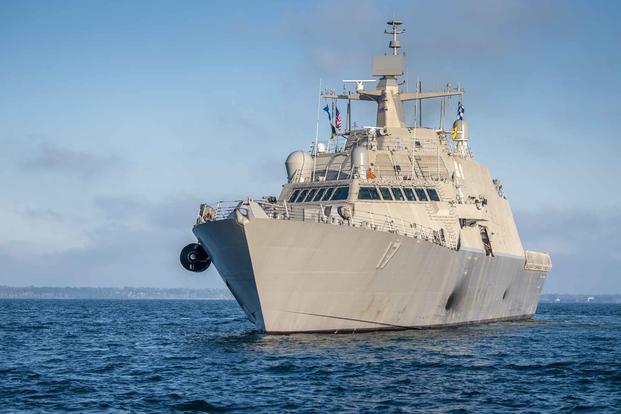The Navy wants to scrap 24 ships this coming year as part of its latest budget proposal, a move designed to give military planners enough money to modernize the rest of the fleet.
The sea service explained as part of the release of its budget request Monday that its ongoing commitment to both the new Ford-class aircraft carriers and the upcoming Columbia-class ballistic missile submarine created a "pressurization," forcing the Navy to decommission the large number of ships.
Rear Adm. John Gumbleton, the Navy's budget chief, told reporters that the plan is to get rid of five cruisers, nine littoral combat ships, four landing dock ships, two submarines, two oilers and two expeditionary transfer docks.
Read Next: Supreme Court Allows Navy to Reassign Vaccine-Refusing SEALs
Gumbelton explained that 56% of their $27.9 billion shipbuilding budget "is for nuclear ships" - the aforementioned Ford and Columbia - and as a result, the Navy officer said the branch was forced to think hard about where to get money to modernize the rest of the fleet.
"A piece of that was our choice going after decommissioning vessels that were very expensive to maintain," Gumbleton said. The 24 ships would generate savings of "3.6 billion across the budget that I can reinvest" over five years, he added, calling it "not an insignificant number."
While the cruisers are aging and nearing the end of their lifespans, the littoral combat ships are newer -- though their development and fielding has been rocky.
The Navy already announced the retirement of four littoral combat ships last year, claiming that they were always meant to be test platforms despite reports to the contrary.
The Freedom-class variant was also found to have a major flaw with its combining gear -- a piece of equipment that transfers power from the ship's engines to its water jets -- early last year. All of the nine LCS ships set to be decommissioned would be the Freedom-class variant.
Gumbleton told reporters that the "drivetrain fix isn't an exorbitant amount of money" and, instead, the focus on one variant was because "there's savings programmatically, instead of having to sustain two different lines."
In 2010 and the early days of the LCS program, the choice to buy two types of ship was presented as an opportunity for savings.
"This option is good for the taxpayers because it enables us to buy more ships for the same money and allows us to lock in a lower price for all 20 ships," Ray Mabus, the then-Navy secretary, said, according to the New York Times.
Another hit for the beleaguered ships is also the end of its anti-submarine warfare mission package, which Gumbleton said was facing "huge challenges -- not gonna work."
Instead, the service will task the upcoming Constellation-class frigate with fighting enemy submarines. The budget also asks for money to build two Virginia-class attack submarines, two destroyers, one frigate, two amphibious ships, an oiler and a salvage ship.
The acting under secretary of the Navy, Meredith Berger, said that the move to ditch the littoral combat ships and mission module is going "to free ourselves [from] more costly repairs and maintenance."
The Navy's acting number two civilian leader said the service remains committed to a 355-ship fleet, but she emphasized that "first and foremost, it's making sure that we have a fleet that has the right mix ... something that we're able to sustain and support."
Gumbleton said that the branch wants "to only buy ships to the extent that we can deliver, and that we can afford to maintain, operate, have weapons and magazines, people, fuel, etc., ... to sustain them."
Congress will take up the budget later this year, although the Navy’s request is likely to see significant changes as lawmakers modify spending plans. That process can also face steep delays -- the 2022 budget wasn’t passed until March of 2022, five months after the fiscal year began.
-- Konstantin Toropin can be reached at konstantin.toropin@military.com. Follow him on Twitter @ktoropin.
Related: Nearly 50 Years of Navy History Is on Its Way to Become Scrap











